

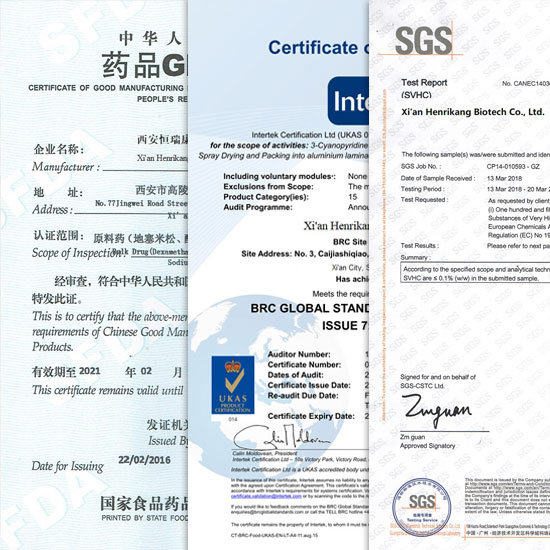



Related Attributes
Product details
| Product Name | Food grade Vitamin A Acetate powder CAS 127-47-9 pure Vitamin A Acetate |
| CAS No. | 127-47-9 |
| Appearance | yellow powder |
| MF | C22H32O2 |
| Purity | 99% min Vitamin A Acetate |
| Keywords | Vitamin A Acetate,Vitamin A Acetate powder,Food grade Vitamin A Acetate |
| Storage | Keep in a cool, dry, dark location in a tightly sealed container or cylinder. |
| Shelf Life | 24 Months |
| >Click here to get more information |
Vitamin A Acetate can be absorbed transdermally, anti-keratinisation, stimulate the growth of collagen and elastin, increase the thickness of epidermis and dermis. It enhances skin elasticity, effectively eliminates wrinkles, promotes skin renewal and maintains skin vitality. It is used in eye cream, moisturising cream, repair cream, shampoo and conditioner.
Functions of Vitamin A Acetate.
Vitamin A acetate can maintain the normal metabolism of the human body, can maintain the stability and development of cell membranes, maintain the normal function of the reproductive system, the formation of vision, easing the keratinisation of the tissues, and enhance the cellular immunity has a significant role.
The vitamin is fat-soluble and is a necessary factor in regulating the growth and health of epithelial tissue cells, thinning the surface of rough aged skin and removing wrinkles. It can be used in skin care, wrinkle removal, whitening and other high-level cosmetics.
Vitamin A Acetate vs Retinol
| Dimension | Retinol | Vitamin A Acetate |
|---|---|---|
| Potency (Bioactivity) | Higher. Retinol is directly usable by the body (no conversion needed) and has stronger biological effects at the same dose. | Lower. It must first be converted to retinol (by removing the acetate group) in the liver before the body can use it. ~20% less potent than retinol by weight. |
| Stability | Less stable. Easily degraded by light, heat, and oxygen (oxidation). Requires opaque, airtight packaging. | More stable. The acetate group protects it from oxidation/breakdown, making it easier to formulate and store (e.g., in supplements or skincare). |
| Irritation Potential | Higher. Directly interacts with skin cells (e.g., accelerates cell turnover), often causing dryness, redness, or peeling (especially at high doses or for sensitive skin). | Lower. Its reduced bioactivity means gentler effects on the skin and digestive system. Rarely causes irritation at recommended doses. |
| Absorption & Metabolism | Absorbed directly in the small intestine (with dietary fat). Immediately available for use in vision, cell growth, etc. | Absorbed similarly (with fat) but requires an extra step: the liver cleaves the acetate group to convert it to retinol. This slower conversion reduces "peak" levels in the blood. |
| Food Sources | Natural animal sources: beef liver, cod liver oil, egg yolks, whole milk. | Not naturally occurring in significant amounts. Mostly synthetic (used in supplements/skincare). |
Key Applications: How to Choose?
A. Dietary Supplements
Vitamin A is essential for vision, immune function, and cell differentiation. In supplements:
Vitamin A acetate is the preferred form. Its stability ensures the nutrient does not degrade during production or storage, and its lower bioactivity reduces the risk of vitamin A toxicity (poisoning caused by excessive vitamin A). Most multivitamins or single-vitamin A supplements use this form.
Retinol is less commonly used in supplements. Its higher bioactivity increases toxicity risk, and it degrades more readily, making it less reliable for long-term use.
B. Skincare
Retinol: The gold standard for anti-aging. It penetrates the skin’s outer layer, converts to retinoic acid (the active form that binds to skin cells), and stimulates collagen production, fades dark spots, and unclogs pores. However, its potency causes side effects (dryness, sun sensitivity) — start with low concentrations (0.25–0.5%) and use 2–3x/week.
Vitamin A Acetate: A “gentle retinoid” for sensitive skin. It converts to retinol slowly in the skin, leading to milder cell turnover and minimal irritation. It is ideal for:
Beginners new to retinoids.
Sensitive or dry skin types.
Preventative skincare (maintaining texture, not targeting severe wrinkles/acne).
Summary: When to Pick Which?
| Goal | Best Choice | Reason |
|---|---|---|
| Daily vitamin A supplementation | Vitamin A Acetate | Stable, low irritation, lower toxicity risk. |
| Anti-aging (wrinkles, dark spots) | Retinol | Higher potency, directly stimulates collagen and cell turnover. |
| Sensitive skin or retinoid beginners | Vitamin A Acetate | Gentle, minimal dryness/redness, gradual effects. |
| Long-term product storage | Vitamin A Acetate | Resists degradation from light/heat/oxygen. |
Uses of Vitamin A Acetate.
Vitamin A oil acetate maintains the normal metabolism of the human body, is able to maintain the stability and development of cell membranes, maintains the normal function of the reproductive system, has a significant effect on the formation of vision, eases the keratinisation of tissues and strengthens the immunity of cells.
It can be absorbed transdermally, anti-keratinisation, stimulate the growth of collagen and elastin, increase the thickness of epidermis and dermis. Enhances skin elasticity, effectively eliminates wrinkles, promotes skin renewal and maintains skin vitality. Used in eye creams, moisturisers, repair creams, shampoos, conditioners, etc.
Product Method of Bulk Vitamin A Acetate Powder.
A method for the preparation of vitamin A acetate, comprising the steps of (1) condensation reaction between 3-methyl-4-oxo-2-buten-1-yl acetate (referred to as C5 aldehyde ester) and tetraethyl methylene diphosphonate under alkaline conditions to obtain the intermediate C6 phosphate ester (chemically named as 5-(diethyl phosphonate)-3-methyl-2,4-hexadien-1-yl acetate); (2) C6 phosphate ester was transposed under alkaline conditions and added to C14 aldehyde (chemically named 2-methyl-4-(2,6,6-trimethyl-1-cyclohexen-1-yl)-3-butene-1-aldehyde) in a Wittig-Horner condensation reaction to produce vitamin A acetate.
Customer Case Study
UK Infant Nutrition Brand
This brand specializes in producing infant formula and complementary foods for children aged 0-3. To meet the EU's stringent requirements for infant vitamin A intake, they selected our vitamin A acetate powder as a nutritional additive. After six months of market testing, the product not only passed the European Food Safety Authority's nutritional assessment but also received positive reviews from 92% of parents—numerous feedback reports indicated smoother infant skin and enhanced resistance to common colds. The brand increased its market share in the UK infant nutrition sector by 15% within one year.
Frequently Asked Questions.
Q: Is vitamin A acetate powder safe for use in infant foods?
A: Yes. Our vitamin A acetate powder complies with EU Regulation (EU) 2016/127 and the U.S. FDA GRAS (Generally Recognized as Safe) standard for infant nutrition products. When used at recommended dosages (e.g., 150-200 IU per 100 grams of infant formula), this product is completely safe and effectively prevents infant vitamin A deficiency.
Q: How does vitamin A acetate powder differ from natural vitamin A sources like beta-carotene?
A: Unlike β-carotene (which requires conversion to active vitamin A in the body with low conversion efficiency), vitamin A acetate powder is a direct active form—its absorption rate exceeds 85%, making it more suitable for populations with weaker conversion capabilities (such as the elderly, infants, or those with digestive disorders). This product also offers higher stability and is less susceptible to degradation from light or heat during processing.
Q: Can customized specifications be provided based on product requirements?
A: Certainly. We can adjust active ingredient concentration (e.g., 250,000 IU/g or 325,000 IU/g), particle size, and carrier (maltodextrin, starch, etc.) according to application scenarios (capsules, tablets, or liquid supplements). Complimentary samples are available for testing to ensure compatibility with your production processes.
Our Strengths.
Henrikang possesses the capability to produce any capsule formulation. From sourcing every ingredient in the formula to post-filling inspection, we deliver end-to-end services at optimal pricing and fastest lead times. With extensive experience, we can assist you in developing new products for your target audience or discuss how to scale production efficiently. As your partner, we are committed to achieving long-term success in capsule manufacturing.
As a leading OEM manufacturer of nutritional supplement ingredients and branded products in China, we hold certifications including ISO 22000, ISO 9001, HACCP, GMP, Halal, CE, CE-ROHS, Kosher, SGS, Intertek, Eurofins, and GMP. Our facility has successfully passed FDA inspection and completed registration.
WHY CHOOES US?

OUR CERTIFICATE
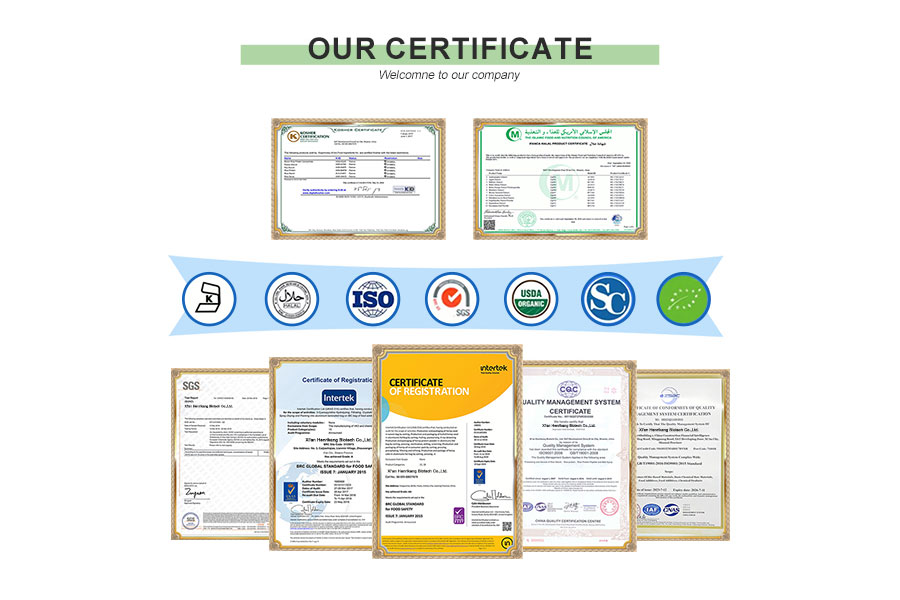
CUSTOM PROCESS
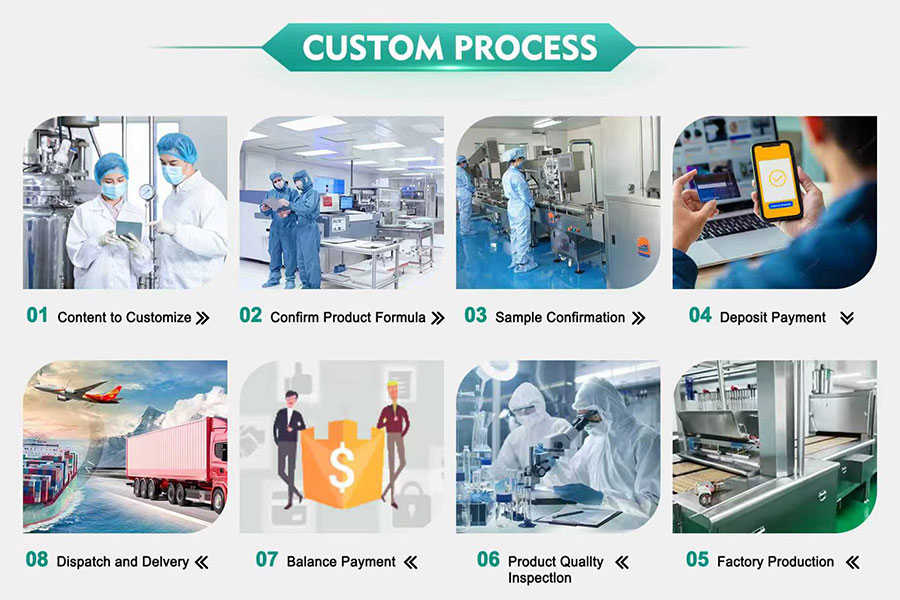
OUR PACKAGE
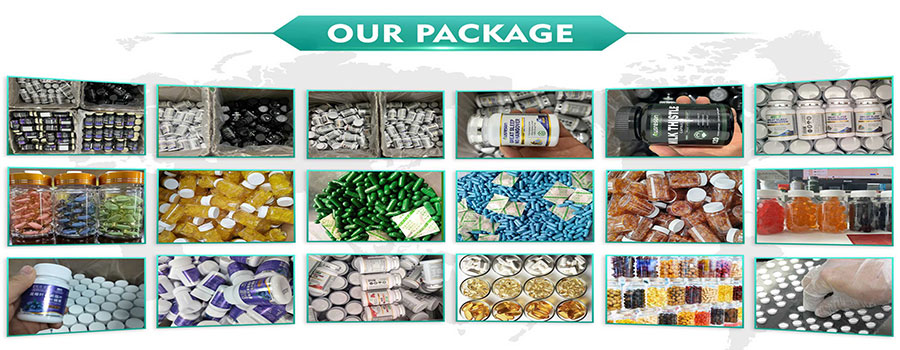
OUR EXHIBITION

OUR FACTORY
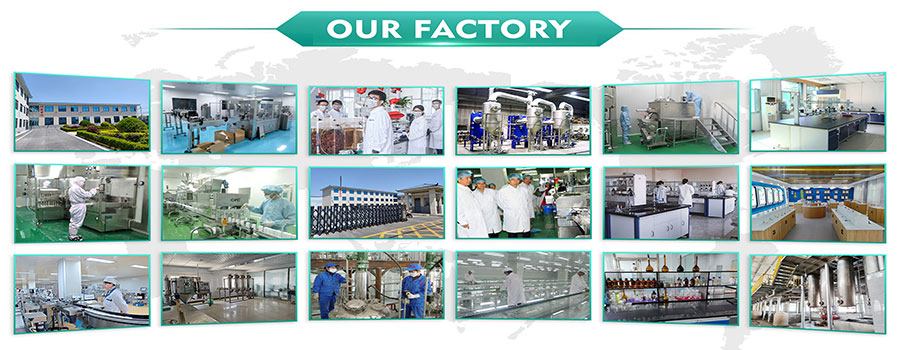
Shipping
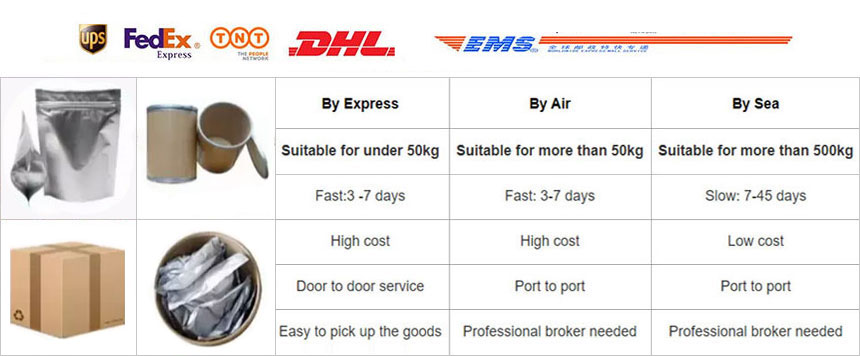
Pharmaceutical Intermediate manufacturers
©2022 Xi'an Henrikang Biotech Co., Ltd.,